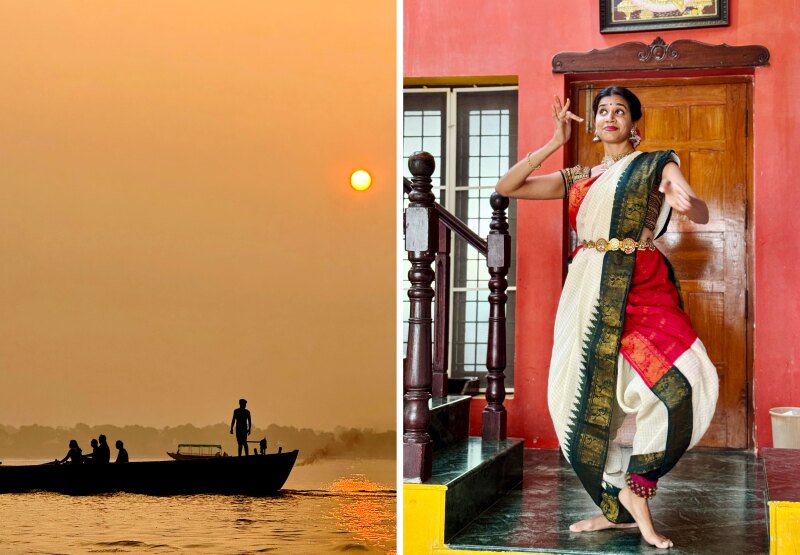The first time I was in India—bewitching, syncretic, electrifying India—was a decade ago. My husband and I spent six weeks pinballing from Punjab to Kerala as part of a yearlong trip across Asia. This time around, I took our two-and-a-half-year-old son, Julian, on our own for 10 days as part of a three-month, 14-country trip around the world.
Knowing how vast India is, and how challenging toddlers can be, I tapped the veteran travel planners at Micato Safaris to map out domestic flights, book our hotels, and arrange day-to-day activities and immersive cultural experiences. The boutique agency operates in numerous countries and has had a foothold in India for more than 30 years. I trusted that its deep local connections and attention to detail would make for a seamless and memorable visit.
My son is on the autism spectrum, but I don’t let that stand in the way of living. I use travel as a means to crack open his world and introduce him to new people, places, cultures, ideas, and experiences. That’s how music became the unofficial theme of our India jag and an enduring source of fascination for him.
Julian had shown interest in music the way many children his age do: windmilling to pop songs and giddily reciting lyrics from Frozen and Moana. But I noticed something different—more pointed, a bit more unusual—about how he experienced music early in our travels.
For everything from a gospel choir in Tanzania to Lali drummers in Fiji, Julian would fixate on the cadence of those voices or the tempo of the instrumentation—hanging on every note as if it were the last. Whereas other toddlers might listen for a spell and then peel away to do something more interesting, like chase a passing dog or stare at an iPad, Julian could focus for an hour straight, totally mesmerized. Heaven forbid the musicians would pause between songs; he’d whoop, “Again! Again!” The encores couldn’t come fast enough.
He even noticed rhythms where others, myself included, just heard noise—like the pulsing click of a baggage carousel. “Listen . . .” he’d say, cupping his tiny starfish hand over his ear and waiting for me to do the same. “Music!”

Micato Safaris arranged exclusive lessons, experiences, and excursions throughout the trip, including a performance by Deepthi Ravichandran in her family home.
Photos by Ashlea Halpern
Our musical adventure in India began in Chennai, capital of Tamil Nadu, where we learned about the classic dance form Bharatanatyam in the dance school and family home of instructor and movement therapist Deepthi Ravichandran (visitors can DM her on Instagram to find out about upcoming events). With cups of gingery inji sorasam in hand, we were treated to a brief history of the more than 2,000-year-old South Indian classical dance form, which has agriculturally rooted devotional songs and movements that reference themes from the Hindu scriptures. But it was Ravichandran’s solo routines, including an EDM spin on a traditional Alarippu dance piece, that really captivated Julian’s imagination.
Ravichandran is an enchanting performer; her doe-like eyes, sly smile, and intricate hand gestures convey emotions and storylines that would otherwise be lost to a language barrier. Julian was particularly intrigued by the jangling of her salangai (brass ankle bells) and studied Ravichandran’s fancy footwork while thumping a thattu kazhi (wooden stick) against a kattai (small wooden block) she’d handed him so he could help keep the beat. At the close of each song, he demanded the usual encore: “Again!”
At our hotel that night, the elegant Leela Palace Chennai, a sitarist, flutist, and tabla and mridangam drummers played live music by the courtyard fountains. When they spotted Julian bopping on the periphery, they played a Tamil version of “Baby Shark,” much to his delight.
The one-on-one Bharatanatyam class seemed hard for the Micato team to top, but top it they did when we later arrived in Delhi, where travel director Puneet Dan arranged a meeting with local pigeon racers on a sun-baked rooftop in the old Muslim quarter. Though not overtly musical in nature, kabootarbazi, as the Mughal-era sport is called, has a surprising sonic element. Julian had a blast cradling the cooing birds and imitating the chant-like calls of the pigeon handlers, flapping his arms with glee as their flocks took flight and landed on command.

Julian (left) loved mimicking the sound of pigeons during the trip.
Photos by Ashlea Halpern
But it was in Varanasi, that sacred city on the Ganges, where Micato pulled its most impressive strings yet—starting with a sunrise sailing on the world’s holiest river soundtracked by the meditative sonatas of a solo flutist. The hot pink sun hung like a neon flame against the morning smog as we boarded a boat garlanded with marigolds. We bobbed past smoldering funeral pyres and throngs of pilgrims wading into turbid waters.
Once the driver cut the engine, it was just us and the music, ethereal and haunting. My son swayed gently between my legs, still wearing last night’s jammies, azure eyes trained on the flutist’s quivering embouchure. When Julian discovered a small, wooden flute waiting for him in our room at Taj Nadesar Palace, he marched joyously around the suite, blowing as hard as he could. (My belated apologies to the other guests.)
The apex of our musical journey, however, was the private concert with Deobrat Mishra, a globally acclaimed multi-instrumentalist and composer and the son of octogenarian sitar maestro Pandit Shivnath Mishra. Here was a guy who tours the world playing 120 concerts a year to fawning fans, and here was my kid, not even three, sitting front row in his home studio in Varanasi, gobsmacked by the breakneck speed at which Mishra’s fingers slid up and down the neck of his surbahar (bass sitar).
We spent an hour like this, Mishra interjecting the jam session with stories of growing up in a musical family, now 11 generations deep, and bragging about his own talented bloodline, including a nephew who plays tabla drums and his sitarist son, both of whom joined him onstage that night. “Again! Again! Again!” Julian cried. Tickled by his enthusiasm, Mishra graciously indulged his demands.
After the show, Mishra told me he’d been watching the rhythm of Julian’s feet while he played and noticed that he “kept perfect count,” no matter how often he switched up the beat. “Your son—he has the music inside him,” Mishra said, gravitas in his voice. And I knew he was telling me something I needed to hear—something that could potentially change Julian’s life.
“When you get home, have him experiment with different instruments and explore all genres of music,” he said. “And keep traveling too. That is the greatest gift of all. I can tell he’s more open-minded and interested in new experiences because he’s already been exposed to so much.”
The validation I felt in that moment was immeasurable. Not just because Mishra saw in my son a talent that I had a hunch might be there, but because he made all the self-doubting and second-guessing I do about my own atypical parenting style disappear.
Mishra’s advice—so generous yet somehow also prescient-feeling—was the most valuable takeaway from our round-the-world trip. When we arrived back home to the Twin Cities last November, I enrolled my son in a musical theater class and bought him drums, an accordion, a miniature piano, and a synthesizer. Who knows what will become of these musical meanderings, but I’m here for it—again and again and again.











